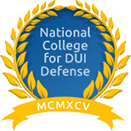Woodbridge NJ Certified SFST Instructors
Field sobriety tests are conducted by law enforcement officers following a traffic stop. The officer must have reason to believe that you are operating a motor vehicle under the influence of intoxicating alcohol or drugs. This is typically accomplished through the officer’s observations including bloodshot eyes, slurred speech, or the smell of alcohol on the driver’s breath. Then, the officer asks the driver to step out of the vehicle to perform certain tests intended to determine whether someone is under the influence. It is important to keep in mind, however, that the National Transportation Safety Administration only sanctions the use of standardized field sobriety tests by police officers (e.g. walk and turn, horizontal gaze nystagmus, ABCs, and the one leg stand). Five (5) of the members of our defense team are among the approximately fifteen (15) in the state certified in these tests and two (2) are actually instructors. We believe that this training is invaluable in providing our clients with the best opportunity to avoid field sobriety test results.
Typical Procedure Following a Stop
One of the initial tests typically performed is “the alphabet” or the “ABCs”. They often ask the driver the recite the alphabet, without singing, and sometimes they ask the driver to perform the alphabet backwards. Another test utilized is to count down from a number backwards and stop at a certain number. For example, they will ask a suspected DWI driver to count down from 27 backwards and stop at 11. The key is to recite every number clearly and to make sure to stop at 11. Many times people forget to stop and count down all the way from 27 back to 1.
Law Enforcement’s Observations of the Driver
The police examine all aspects of an individual’s behavior when they are suspected of drinking and driving. This includes:
- Ability to Walk: Unable to Walk, Falling, Staggering, Swaying, and Grasping for Support
- Ability to Stand: Swaying, Unable to Stand, Continual Leaning, Sagging at Knees, and Feet Wide Apart for Balance
- Speech: Shouting, Slobbering, Slurred, Rambling, Incoherent, Whispering, and Boisterous
- Demeanor: Fighting, Indifferent, Antagonistic, Polite, Sleepy, Excited, Cooperative, Calm, and Crying
- Actions: Punching, Resisting, Kicking, and Threatening
- Eyes: Bloodshot, Watery, and Droopy Eye Lids
- Clothing: Mussed, Partly Dressed, Neat, and Vomited On
- Hand Movements: Fumbling or Slow
- Face: Flushed or Pale
- Odor of Alcoholic Beverage: Yes or No?
It is often based on these observations that the police officer believes the driver is operating the motor vehicle under the influence of alcohol. As a result, Field Sobriety Tests are conducted.
- Field Sobriety Tests: The Horizontal Gaze Nystagmus Test. The Horizontal Gaze Nystagmus Test (HGN) is one of the Field Sobriety Tests typically conducted by law enforcement when investigating a DWI offense. Essentially, the test is administered by the police officer who holds an object, usually a pen or a flashlight, vertically between twelve (12) and sixteen (16) inches from the driver’s face, just above eye level. The driver is instructed to keep his or her head still and to follow the object only with the eyes. The administrator will then move the object slowly from side to side. The object of the test is to determine if the eye can maintain focus on the object or is “jerking” or “bouncing” side to side. Alcohol affects the brain’s ability to control the driver’s eyes and eye muscles and results in increased jerking or bouncing of the eyes. An individual is likely to fail the test if there is an inability to follow the object smoothly, if the individual is unable to maintain focus on the object, and there is increased jerking or bouncing of the eye based on alcohol consumption.
- The Walk and Turn Test. Most individuals are familiar with the “Walk and Turn” test utilized by law enforcement officers to determine a driver’s level of intoxication. This is the famous “walk a straight line” test attempted by many party goers to show that they are not intoxicated or drunk. Some of us are better at it then others. The test requires that the driver stand on a line with his feet in a heel to toe position, left foot in front of the right. The driver should keep his arms at his sides, listen to the complete instructions, and he or she should not begin until told to do so. The driver is instructed to take nine (9) steps along the straight line, heel to toe, while counting the steps out loud and watching his or her feet. When he or she gets to the end stop and return in the same manner. Some of the typical reasons for failure of the walk and turn test include: Driver starts the test before the instructions are completed or they are told to begin; Driver can’t maintain balance while listening to instructions;·Stops walking to steady self; Does not touch heel to toe; Loses balance while walking (steps off the line);Uses arms for balance (raises arm over six (6) inches);Loses balance while turning, turns incorrectly; Incorrect number of steps; Cannot do test (steps off the line three or more times).
- The One-Leg Stand Test. The One-Leg Stand test is the third field sobriety test that is frequently utilized by law enforcement officers. This test requires that the driver stand with her feet together and her arms at her sides. The driver then must stand with one foot (either foot) six (6) inches off the ground, toes pointed out, while counting aloud (one thousand one, one thousand two, one thousand three, etc.). The driver must also look at the raised foot, keep the foot raised until told to stop, and do not hop, sway, or use your arms for balance. The most common reasons a driver fails the One-Leg Stand Test are: Sways while balancing; Uses arms to balance (raises arms over six (6) inches); Hopping; Puts foot down; Cannot do test (puts foot down three times).
- ABCs
Highly Trained Woodbridge NJ DWI Lawyers
The aforementioned four (4) tests are the standardized field sobriety tests used in New Jersey. If you have further questions regarding DWI charges in New Jersey, please contact our experienced DWI lawyers today. The Law Offices of Jonathan F. Marshall is the largest DWI law firm in all of New Jersey. In fact, one of our attorneys is only one of five lawyers in New Jersey certified to be a DWI Detection and Standard Field Sobriety Testing Instructor. Our team is trained to investigate every aspect of your field sobriety test and to identify any potential faults with how the testing was conducted. We can then expertly defend against your charges in court. Call our Woodbridge office at 732-751-4458 today for a free initial consultation.













